Professor Alan Gilchrist's talk
in Ritsumeikan (March 17, 2006) Program
Opening talk (16:00-16:30)
"Ilusions of brightness or lightness"
Akiyoshi Kitaoka, Associate professor Ph.D (Ritsumeikan University, Dept. of Psychology)
since March 16, 2006 (7 digits since January 15, 2013)
Welcome!
Contents
Part 1. Illusory staircase Gelb effect: A new illusion
Part 2. Luminous fields appear darker than white ones
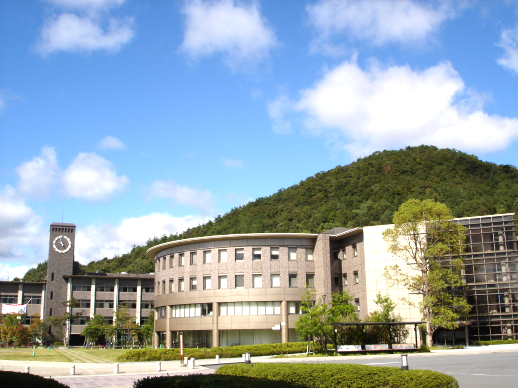
Soshi-kan and Mt. Kuniugasa-yama
Part 1. Illusory staircase Gelb effect: A new illusion(1) Illusory staircase Gelb effect
The highest lightness rule is necessary, not the highest luminance rule.
Basic illusion (Luminance-gradient-dependent lightness illusion)
(2) Illusory staircase reverse Gelb effect
The lowest lightness rule is necessary in this condition.
Is the "reverse Gelb effect" possible?
A white cardboard in front of intensely bright background might possibly appear to be black until inserting a darker one in the visual field (lowest luminance rule?).
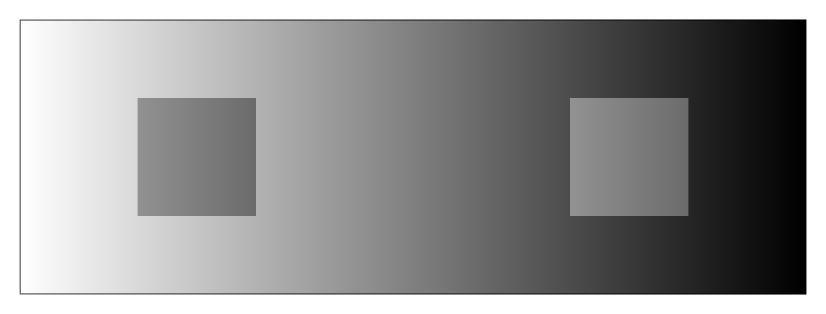
Luminance-gradient-dependent lightness illusion*
*The term "Luminance-gradient-dependent brightness contrast" is also possible.
The left square appears to be darker than the right one, though they are identical in luminance gradient.
produced by Akiyoshi .Kitaoka 2006 (March 16)
cf. Land, E. H. and McCann, J. J. (1971) Lightness and retinex theory. Journal of the Optical Society of America, 61, 1-11. <touched up April 9, 2006>
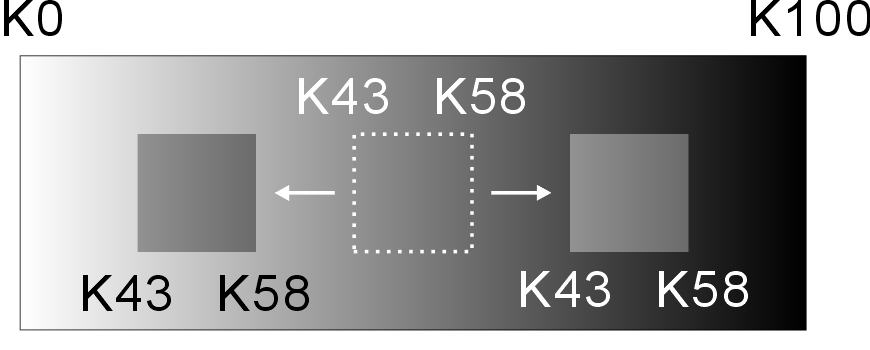
"Anatomy" of the luminance-gradient-dependent lightness illusion
produced by Akiyoshi .Kitaoka 2006 (March 16)

"Robot"
The left circle appears to be lighter than the right one, though they are identical in luminance.
Copyright Aiyoshi Kitaoka 2005 (December 10)

"Ninja"
The lightness of both eyes appears to be different from each other, but they are of the same luminance.
Copyright Aiyoshi Kitaoka 2005 (August 13)
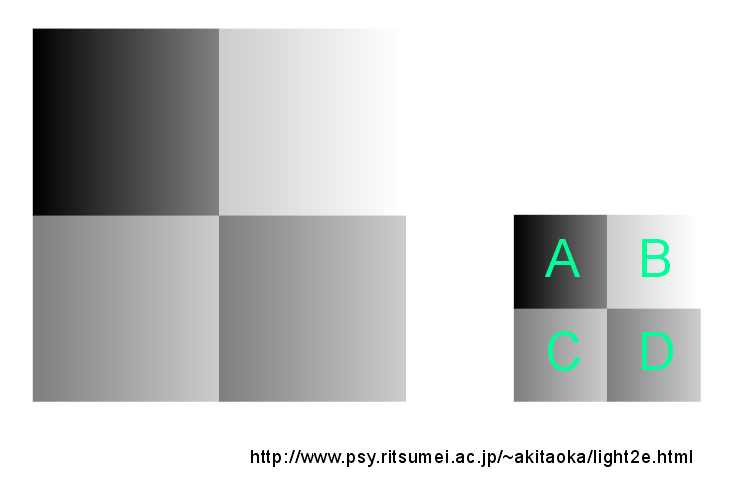
"Adelson's checker-shadow illusion-like gradation lightness illusion"
Physically, C = D !
Copyright Aiyoshi Kitaoka 2005 (August 12)
cf. Adelson's checker-shadow illusion
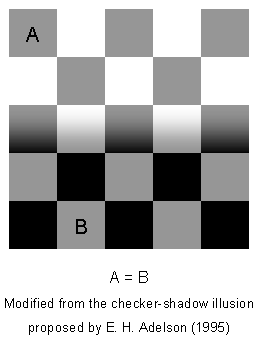
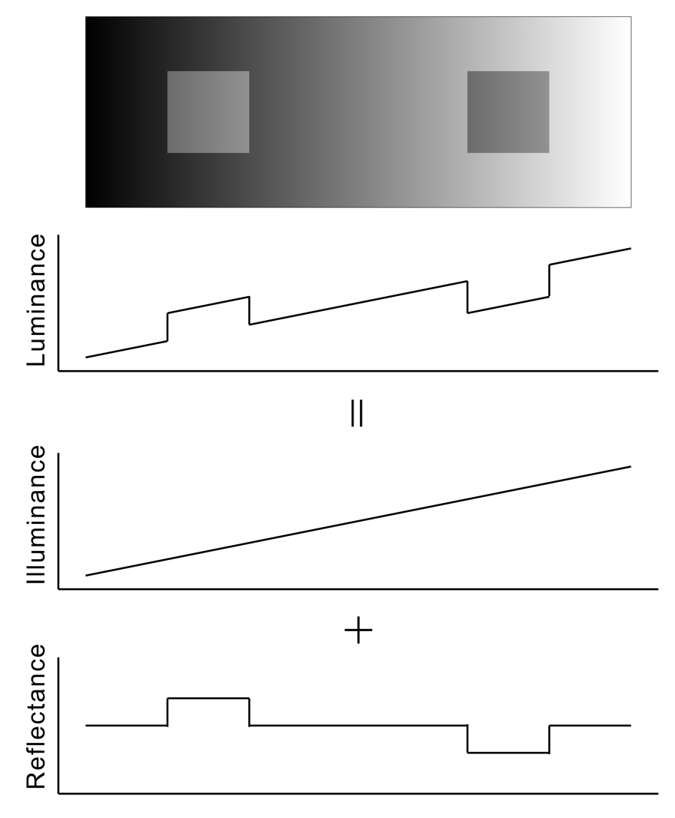
Intrinsic model of the luminance-gradient-dependent lightness illusion
In this model, the luminance profile is explained as the summation or multiplication of illuminantion and surface reflectance.
produced by Akiyoshi .Kitaoka 2006 (March 16) (corrected Jnuary 11, 2017)
(original, wrong version)
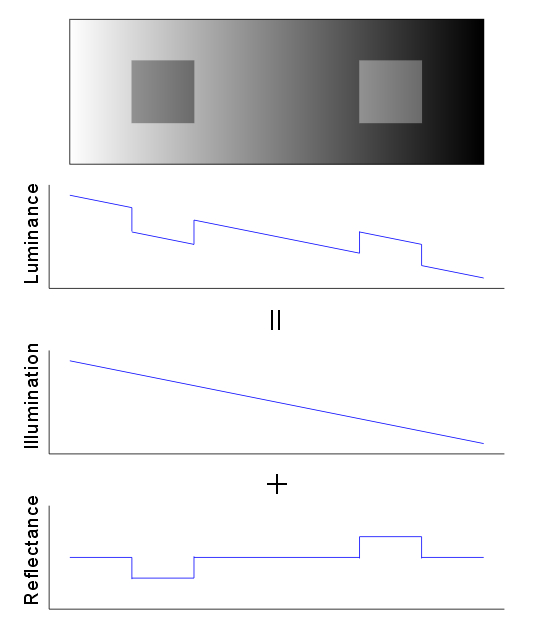
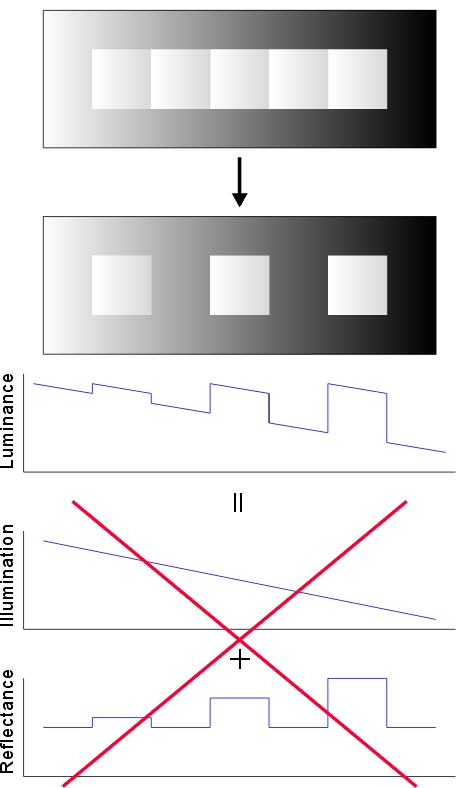
The intrinsic model fails
If squares are placed separately, each square appears to be white. The leftmost one appears to be a white square with reduced pronounceness behind some "white mist".
produced by Akiyoshi .Kitaoka 2006 (March 16)
![]() It is suggested that information of perceived luminance or brightness should
also be taken into account.
It is suggested that information of perceived luminance or brightness should
also be taken into account.
Jump back to the title of this part to see the "illusory staircase reverse Gelb effect"
Part 2. Luminous fields appear darker than white ones
Question: Are luminous fields really brighter than white parts?
Answer: In the real environment "Yes", while in pictures or drawn images "No".
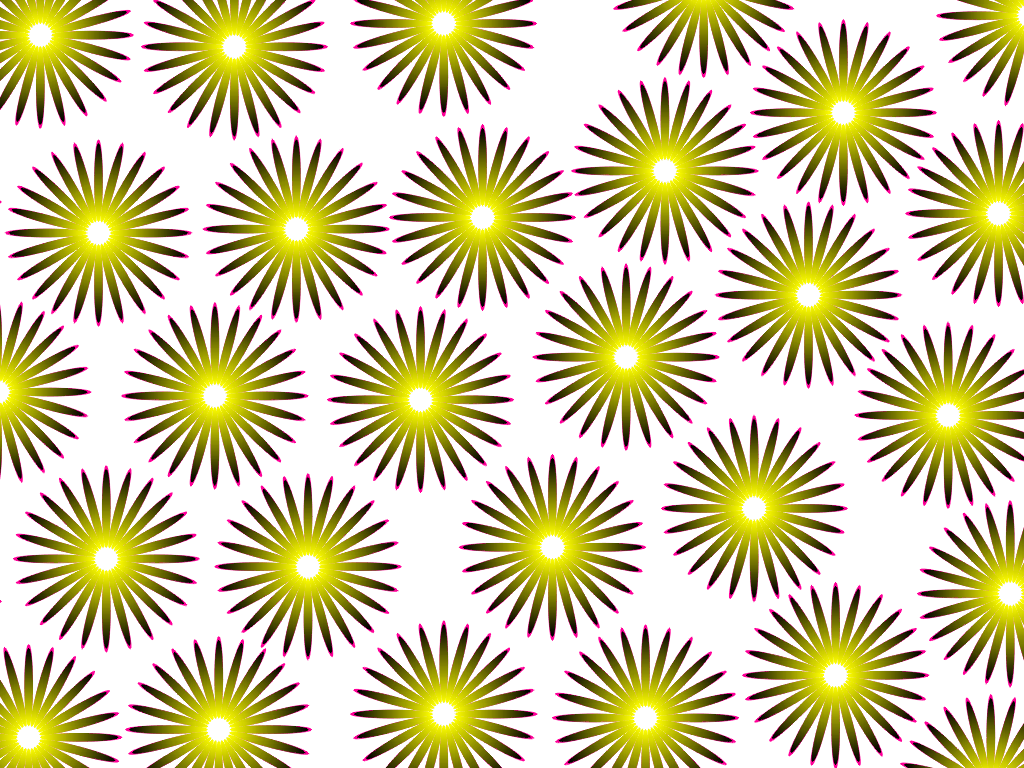
"Sea urchins"
Sea urchins appear to shed light.
Copyright Akiyoshi Kitaoka 2005 (August 11)

"The sun"
The sun appears to expand.
Copyright Akiyoshi .Kitaoka 2006 (February 25)

Counterphase brightness induction
The left bar appears to be darker than the right bar in each image.
![]() The luminous bar (top left) appears to be darker (if observerd
locally) than the white bar (top right).
The luminous bar (top left) appears to be darker (if observerd
locally) than the white bar (top right).
![]() My speculation is that the highest luminance rule ignores the field that
gives luminous appearance.
My speculation is that the highest luminance rule ignores the field that
gives luminous appearance.
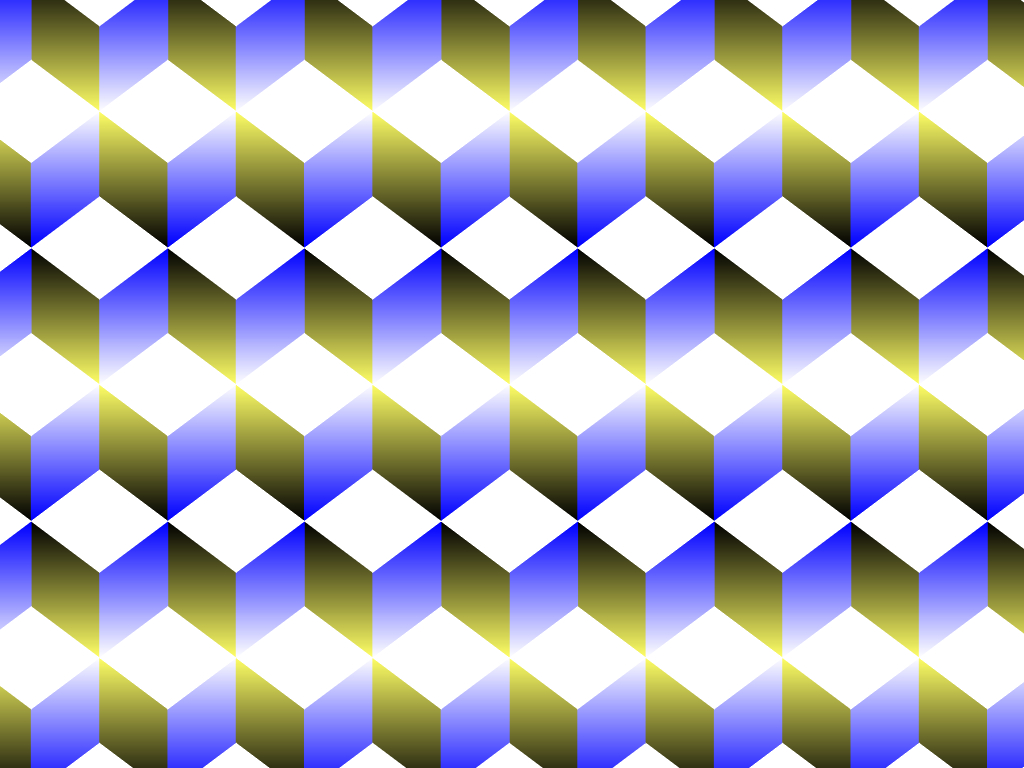
"Light of cubes"
There are glaring white diamonds and no-glare one, though they are identical in luminance. Moreover, the former appears to be darker than the latter when observers compare them in an analytical manner.
Copyright Akiyoshi Kitaoka 2005 (October 4)
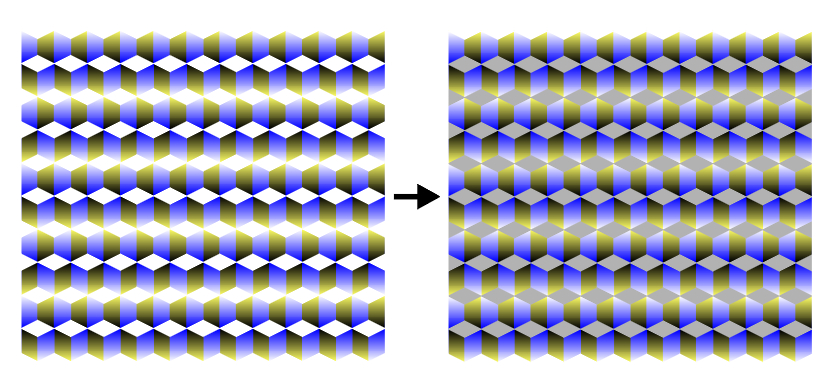
White diamonds are identical within the left image, though they appear to be different. Gray diamonds are identical in the right image, though they appear to be different (Logvinenko illusion).
produced by Akiyoshi .Kitaoka 2006 (March 16)
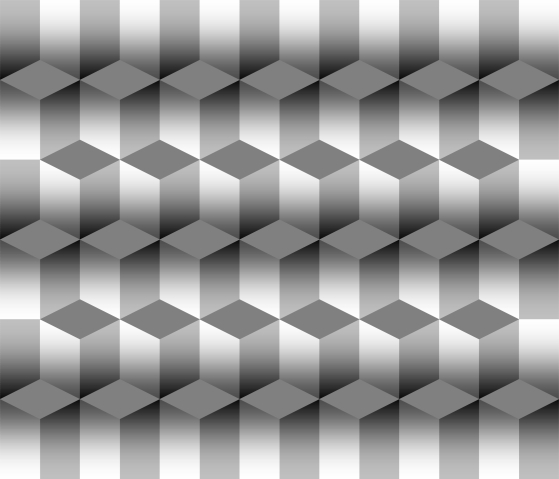
Logvinenko illusion
Although gray diamonds are identical, there appear to be light-gray ones and dark-gray ones.
Logvinenko, A. D. (1999) Lightness induction revisited. Perception, 28, 803-816.
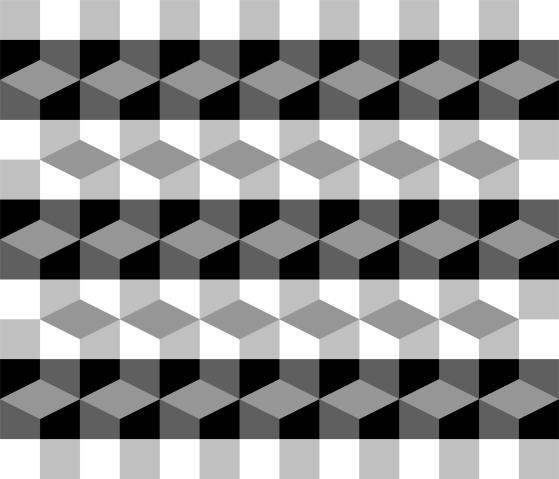
One of Adelson's illusions
Although gray diamonds are identical, there appear to be light-gray ones and dark-gray ones.
Adelson, E. H. (1993) Perceptual organization and the judgment of brightness. Science, 262, 2042-2044..
Adelson, E. H. (2000) Lightness perception and lightness illusions. In M. Gazzaniga (Ed.), The New Cognitive Neurosciences, 2nd ed. Cambridge, MA: MIT Press. (pp. 339-351)
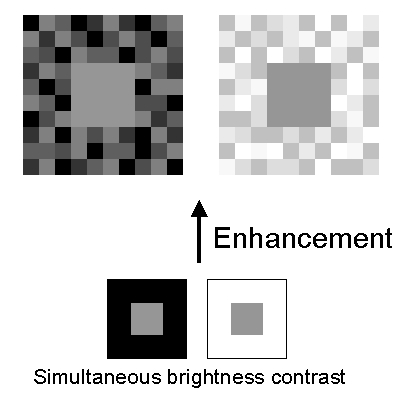
One of Gilchrist's illusions
Articulated surrounds enhance simultanous brightness contrast. The inner square in the left image appears to be lighter than the one in the right image.
Gilchrist, A., Kossyfidis, C., Bonato, F., Agostini, T., Cataliotti, J., Li, X., Spehar, B., Annan, V., and Economou, E. (1999) An anchoring theory of lightness perception. Psychological Review, 106, 795-834.
Gilchrist, A. and Annan, V. Jr. (2002) Articulation effects in lightness:Historical
background and theoretical implications. Perception, 31, 141-150.
One of my lecture pages demonstrating this illusion (in Japanese)
Thank you